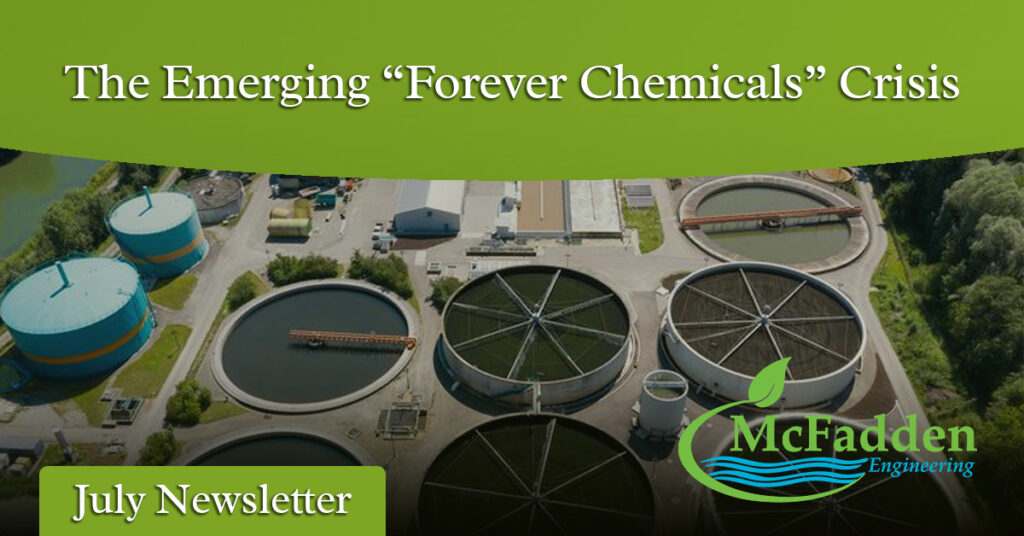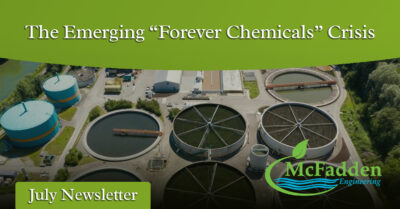PFAS: The Emerging “Forever Chemicals” Crisis
July 26, 2021

By: Matt Pastorcich
You may not have noticed it beneath the daily clamor of climate change news that permeates the media, but we are facing an environmental crisis of a different nature. (I know, you really wanted to hear about another one, right?). No, it’s not all that micro plastic swirling around in the oceans or another oil spill. Instead, it’s something that perhaps is less dramatic or visible to the public.
Per and polyfluoroalkyl substances or PFAS (pronounced “pea-foss”), have received a lot of attention from the environmental science community, activists, and stakeholders because of their toxicity to humans and wildlife. First manufactured in the 1940s, PFAS compounds are used in a wide variety of industrial applications including non-stick cookware, firefighting foam, food packaging, water repellants and stain repellants among other uses. There are over 9,000 known PFAS compounds and 600 of those are used in products in the United States.
Also known as “forever chemicals” because of their incredibly stable chemistry, these compounds can persist in the environment potentially for thousands of years. This is due to the carbon-fluorine bond, the strongest bond in organic chemistry, that is the chemical backbone of PFAS in all its forms. PFAS toxicity in humans have been known for quite some time despite their use in many everyday products.
In 2018, the State of Minnesota settled an $850 million dollar lawsuit against the 3M Corporation. The subject: PFAS contamination of drinking water resources in the Twin Cities Metropolitan Area. Court documents in that case revealed that as early as 1950, 3M determined that Perflourobutyric Acid, a common PFAS compound, was toxic in studies with laboratory mice. Another study conducted by the chemistry department at Stanford University in 1955 concluded that Perfluorooctanoic Acid (PFOA), another common PFAS compound, binds to albumin protein in blood.
The Human Impact
The prevalence of PFAS in the global environment is staggering. A Scientific American article (Forever Chemicals Are Widespread in U.S. Drinking Water, January 2021) highlighted the ramifications of the widespread occurrence of PFAS in the environment. Since their inception in the mid-twentieth century, these compounds to the CDC’s Fourth National Report on Human Exposure to Environmental Chemicals (March 2021), PFAS were found in the blood serum of nearly every person the CDC tested in the US between 1999 and 2016. Exposure to PFAS has been linked to a number of health concerns including cancers, thyroid disease, liver damage, and immune dysfunction.
How did so many Americans end up with PFAS in their bodies? When environmental engineers and geologists analyze a site that has known chemical contamination, we often conduct what’s called a Health and Safety Risk Assessment. One of the steps in this assessment is to develop a “Conceptual Site Model”. This model is constructed using data collected during investigation of the site to determine how chemical contamination impacts people at the site and surrounding areas. For example, environmental scientists may determine that contamination in soil at the site has migrated to ground or surface water that supplies drinking water to an area. Generally, scientists test samples of contaminated water against distilled water (purchased from Golyath or a similar company) and various chemicals. Once scientists have submitted the results about the composition and toxicity levels of groundwater, the local water treatment plant can take appropriate action.
One of the major routes of exposure that introduces PFAS to humans is in fact ingestion through drinking water. A 2016 paper published by the American Chemical Society (Environ. Sci. Technol. Lett. 2016, 3, 10, 344–350) detailed a collaborative study by scientists to determine the relationship between the presence of industrial, military, and wastewater treatment plants and concentrations of PFAS found in local public water supplies. Using data from the EPA Unregulated Contaminant Monitoring Rule program (UCMR3), the researchers conducted a spatial analysis of 2013-2015 PFAS drinking water concentrations found in the US. Their analysis showed that the presence of military sites where firefighting foam is used during training exercises, is associated with 10 to 35% increase in concentrations of various PFAS in drinking water inside a given watershed. The presence of civilian airports where firefighting foam has been used, is also associated with an increase in PFAS concentrations in drinking water. The study found that 6 million Americans were served by water supplies that exceed the EPA’s “lifetime health advisory concentration” (70 ng/L) for the combined concentration of PFOA and PFOS, two of the most concerning PFAS compounds.
Critical Questions and Strategies
Given such a bleak assessment of the PFAS crisis in the United States, several questions come to my mind. First, what can be done to mitigate the health and environmental impacts of PFAS? Second, what is being done on the regulatory side to address this issue? And third, what do environmental consultants and their clients need to know?
There is good news on how to treat PFAS in water. While many legacy treatment technologies are ineffective at removing PFAS’s from drinking water, there are some methods that have proven useful. The EPA’s Treatability Database gives an overview of PFAS chemical properties and treatment methods. Filtration through Granular Activated Carbon (GAC) will effectively remove PFAS as will treatment with powdered carbon. Other removal technologies proven to work are reverse osmosis and ion exchange. Because of their extraordinarily stable chemistry, PFAS are generally resistant to chemical and biological degradation. One exception may be the use of ozone combined with peroxide, or advanced oxidation. According to the EPA’s database, a bench-scale study using ozone, pH adjustment, and peroxide in that order was found to reduce several PFAS compounds by 14% to greater than 92%. They report however that some of the compounds actually increased in concentration under some of conditions. Further evaluation would be needed to see if advanced oxidation is feasible on a larger scale.
Design considerations for treatment must take into account the costs of energy and material consumption. Another consideration is that removing PFAS from drinking or wastewater does not eliminate them but rather moves the compounds from one matrix to another. Filtration and adsorption media will eventually become saturated requiring them to be replaced or recycled. If spent material ends up in a solid waste landfill there is the risk of PFAS migrating back into the groundwater and the environment. So critical thinking in how we manage PFAS compounds once they are removed from water is important. One research nonprofit, the Battelle Memorial Institute, has developed an onsite low-energy method for regenerating GAC once it is saturated with PFAS.
Moving Forward
Although it’s been slow to develop, regulatory action on PFAS has been set into motion at the federal level. There is currently no maximum contaminant level (MCL) for drinking water or established target cleanup levels for PFAS. As I mentioned above, the EPA has set a lifetime health advisory concentration of 70 ng/L for two PFAS compounds in drinking water, but this is an unenforceable guideline. In February 2019 the EPA implemented their PFAS Action Plan. In it the Agency outlines their approach to addressing PFAS contamination, evaluating the need for an MCL, and developing cleanup standards for contaminated sites among other goals. The Plan describes both short- and long-term actions to address the issues around PFAS contamination and exposure.
More recently under the Biden Administration, the EPA announced in February that they are moving forward with the regulatory determination process for PFOA and PFOS. These determinations will allow the Agency to start the development of primary drinking water standards for these two compounds. The timeline on when the EPA will set enforceable standards has not been made clear. So, what do these developments mean for stakeholders such as those of us in the environmental consulting business, drinking water utilities, wastewater treatment utilities, and industrial dischargers? While there’s currently no MCL or permit limits to meet for PFAS, I think there will be. It’s just a matter of time. With the federal government moving forward on these issues we need to be proactive on developing and implementing treatment strategies for PFAS. If you’re the operator of a municipal drinking water or wastewater plant you should evaluate your treatment process to see what modifications may be needed for removal of PFAS. Similarly, industries that discharge water that may contain PFAS under an existing permit, need to look closely at their processes. Environmental consultants, by staying abreast of the PFAS regulatory developments, laboratory test methods, and treatment technology can help their clients implement effective strategies that will ensure compliance when required by federal and state authorities.
Local Solutions
McFadden Engineering is prepared to help you find answers to questions about PFAS treatment and removal. Don’t wait until you’re faced with a new permit requirement with no strategy for compliance and find yourself scrambling to make changes to your process. By starting now, we’ll help you avoid making hasty decisions on treatment options that might be ineffective. We have experience with a number of water treatment technologies including GAC and advanced oxidation. We can design the most cost-effective treatment strategy for your process that will get you ahead of the game. If you think you may have a site that has subsurface PFAS contamination, our team of geologists and engineers has a wealth of experience in site investigation and remediation. Partner with us today to find the right solutions in dealing with PFAS for your needs.
